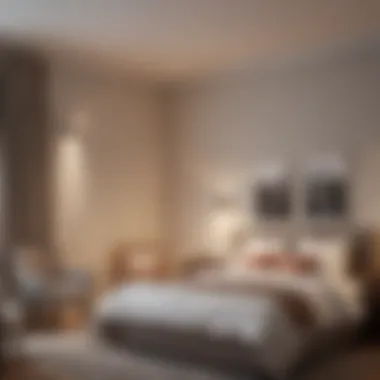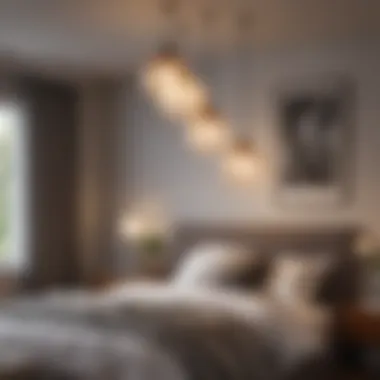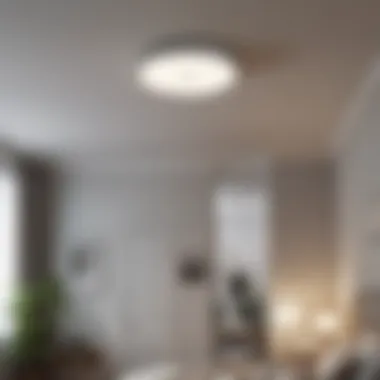Modern Bedroom Lighting: Your Ultimate Ceiling Guide


Intro
Lighting plays a vital role in the overall ambiance of a bedroom. It not only affects visibility but also influences mood and functionality. Modern lighting solutions have evolved far beyond basic illumination. In today's design, the ceiling serves as a pivotal point for various lighting fixtures.
This article explains how to choose the right ceiling lights, focusing on different styles, their aesthetic impact, and energy efficiency. Furthermore, we will explore layering light and practical installation tips. Being aware of current trends can enhance one’s understanding of how to make an informed selection that complements their unique style.
Design Inspiration
When it comes to bedroom aesthetics, the lighting design can either elevate the space or detract from its overall appeal. Current trends in lighting design can be particularly influential in shaping how a bedroom feels. Let's discuss some trending styles and themes.
Trending Styles and Themes
Modern bedroom lighting features various styles, from minimalistic fixtures to more ornate designs. Some of the prominent styles include:
- Industrial: Characterized by exposed bulbs and raw materials, often giving a rustic vibe.
- Scandinavian: Focuses on natural elements and simplicity, involving soft lighting.
- Contemporary: Integrates sleek lines and geometric shapes, often using metallic finishes.
Each style can affect how light interacts with colors and furniture in the room. For example, sleek metallic fixtures can contrast nicely against warm wooden tones, creating a striking visual effect.
Color Palettes and Combinations
Color choices can significantly impact how light is perceived in the room. Light colors can make a small space feel larger, while darker shades provide intimacy. Consider the following combinations:
- Neutral Tones: Such as whites and beiges, complement various lighting styles.
- Bold Colors: Like navy blue or forest green, can create a dramatic effect when paired with bright fixtures.
- Monochromatic Schemes: Utilizing different shades of a single color can be cohesive and elegant.
Lighting fixtures should harmoniously blend with these palettes to enhance the overall look.
"The right lighting can transform a bedroom from merely functional to truly inviting."
Preface to Modern Bedroom Lighting
Designing a bedroom requires thoughtful consideration, especially in lighting. Proper lighting plays a crucial role in how a space feels and functions. It enhances beauty, provides functionality, and even influences mood. Understanding modern bedroom lighting not only involves aesthetics but also practical aspects like energy efficiency and versatility.
Importance of Proper Lighting
The significance of proper lighting in a bedroom cannot be overstated. It affects daily routines such as reading, adjusting the ambiance for relaxation, or creating a vibrant atmosphere for social gatherings. Insufficient lighting can lead to frustration and discomfort. Good lighting illuminates areas to perform tasks efficiently while contributing to a calming environment. Moreover, effective lighting can accentuate design elements, making art pieces and furniture stand out. Key points to consider include:
- Task Functionality: A well-lit bedroom supports various activities—whether it is for work, relaxation, or self-care.
- Mood Enhancement: Colors and intensities of light can evoke different feelings, allowing a space to transition based on the time of day or personal mood.
- Safety and Accessibility: Adequate lighting helps in avoiding accidents and ensures that movement through the space is safe.
The Evolution of Bedroom Lighting
Bedroom lighting has undergone significant transformations over the years. Traditionally, it relied heavily on basic incandescent bulbs and natural sunlight. In recent decades, there has been a shift towards more sophisticated designs and energy-efficient solutions. An examination of this evolution reveals:
- Technological Advances: Introduction of LED lights, which last longer and consume less energy compared to older technologies.
- Aesthetic Variety: From ornate chandeliers to sleek minimalist designs, modern lighting fixtures now cater to diverse tastes and needs.
- Smart Lighting Systems: Integration of technology allows homeowners to control lighting via smartphones or voice commands, adding convenience and flexibility.
This evolution reflects broader trends in interior design and lifestyle preferences, emphasizing the importance of adapting lighting solutions to meet contemporary demands.
Understanding Ceiling Lighting Types
In the realm of modern bedroom lighting, comprehending the various ceiling lighting types can dramatically alter both functionality and aesthetic appeal. Each type presents unique opportunities and challenges in terms of installation, maintenance, and style integration. This understanding helps homeowners and design enthusiasts alike make informed choices that enhance their spaces. From providing adequate illumination to serving as art pieces themselves, ceiling fixtures can influence the ambiance of a room significantly.
Flush Mount Fixtures
Flush mount fixtures are ideal for rooms with low ceilings. These designs are mounted directly to the ceiling and do not protrude, which makes them a practical choice for areas where headspace is a concern. The variety in style ranges from contemporary to traditional, ensuring a fit for almost any decor scheme. Moreover, they often provide broad light distribution, effectively illuminating small to medium-sized bedrooms.
Considerations include the type of bulb used. Energy-efficient options like LED can reduce electricity costs while providing ample light quality. Flush mount fixtures can also act as a base layer in a layered lighting approach.
Pendant Lights
Pendant lights add a stylish touch to any bedroom. These fixtures hang from the ceiling and come in various shapes, colors, and designs. Pendant lighting can serve as a focal point, especially when hung over bedside tables or in corners where additional illumination is necessary. Hanging height plays a crucial role in the effectiveness of these lights; too low may obstruct, while too high diminishes their aesthetic value.


Additionally, they allow for creative expression through unique designs. Homeowners can choose fixtures that reflect personal taste, thereby enhancing the room’s overall character. It is essential to consider the room's layout when incorporating pendant lights.
Chandeliers
Chandeliers transcend mere functionality. They embody elegance and serve as a statement piece in a bedroom. Available in a vast range of styles, from ultra-modern to vintage, chandeliers can dramatically elevate the aesthetic appeal of any space. Their capacity to distribute light effectively makes them suitable for larger bedrooms where general illumination is necessary.
Chandeliers can be a significant investment, thus careful selection is vital. Consider a design that harmonizes with existing decor elements while also enhancing the space's overall ambiance. A well-placed chandelier can create a blend of style and sophistication.
Recessed Lighting
Recessed lighting involves fixtures that are mounted above the ceiling line, creating a clean and unobtrusive look. This type is particularly useful in modern designs where minimalism is desired. Recessed lights can be strategically installed to highlight specific areas in the bedroom, such as artwork or architectural features. They provide flexibility since they can be set to different brightness levels.
However, the installation process can be complex and may require professional assistance. When planned thoughtfully, recessed lighting can create a soft, inviting atmosphere while maintaining an uncluttered ceiling line.
Track Lighting
Track lighting is a versatile solution that allows for adjustable light direction. This system comprises multiple light fixtures attached to a single track, letting the user focus light where it’s needed most. Designed for highlighting specific areas, track lighting is especially beneficial in spaces where task lighting is crucial, such as reading nooks or workspaces within the bedroom.
Consider the overall design theme of the room when selecting track lighting systems. They come in various finishes and styles, making them suitable for both contemporary and traditional settings. Importantly, installation must consider room layout to optimize light distribution throughout the space.
The right ceiling lighting type can dramatically affect both the functionality and aesthetic of a modern bedroom, making careful selection essential.
Layering Light in the Bedroom
Layering light is crucial for a well-designed bedroom. By integrating different types of lighting, you create depth and enhance the overall aesthetic. Properly layered lighting can define spaces, boost functionality, and improve the mood of the room. It's not only about illumination; it's about creating an inviting atmosphere that suits various activities and times of day.
Ambient Lighting
Ambient lighting provides the overall illumination for the bedroom. It sets the stage for the room's mood and overall feel. Common sources include ceiling fixtures, floor lamps, and wall sconces. It ensures that the space is evenly lit, eliminating harsh shadows that can interfere with comfort. When selecting ambient lighting, consider the brightness. Bulbs with a warm tone can create a soothing environment conducive to relaxation.
For instance, a flush mount ceiling fixture can be an ideal option. It offers a clean look without taking up much space, perfect for rooms with lower ceilings. Similarly, dimmable options enhance versatility, allowing you to adjust the light levels according to time of day or activity. Overall, ambient lighting serves as the foundation of your bedroom lighting scheme.
Task Lighting
Task lighting is essential for specific activities within the bedroom. It includes bedside lamps for reading, desk lamps for work, and focused ceiling lights for tasks such as organizing clothing. This type of lighting needs to be bright enough to illuminate without causing strain on the eyes. The placement matters, as it should be positioned to direct light exactly where it is needed.
Adding bedside lamps with adjustable necks can provide flexibility for reading or relaxing in bed. Wall-mounted reading lights are also beneficial as they can save space on nightstands. Additionally, consider under-shelf lights in closets for easy viewing of clothing choices. Task lighting increases functionality, ensuring that your bedroom adapts to your lifestyle.
Accent Lighting
Accent lighting brings focus to specific features or areas within the bedroom. It can highlight artwork, architectural details, or collections that the homeowner wishes to showcase. This form of lighting adds drama and visual interest to the overall design. Options for accent lighting include wall-mounted fixtures, spotlights, and even LED strips.
For example, wall sconces placed next to artwork create a striking focal point while adding ambience. Use dimmable lights to fine-tune the effect and create layers within the design. Remember that accent lighting is about creating contrast; it should not dominate but rather compliment the overall lighting plan.
"Layering light is not just a trend; it is an essential design principle for creating versatile, inviting spaces in the home."
In summary, layering light improves functionality and enhances the ambiance of a bedroom by thoughtfully combining ambient, task, and accent lighting. Each layer serves a specific purpose, contributing to a well-rounded and aesthetically pleasing environment.
Choosing the Right Style
Choosing the right style for bedroom lighting is more than a simple decorative decision. It significantly influences the overall aesthetic and functionality of the space. The style affects how light interacts with the room's design elements, whether they are furniture, wall colors, or decor items. Appropriate lighting can enhance the beauty of a room while also providing the necessary illumination for different activities.
Understanding various styles allows homeowners and design enthusiasts to select fixtures that complement their vision. Each design approach contributes to the mood and atmosphere of the bedroom. Moreover, specific lighting styles can affect perception of space, making a room feel larger or more intimate depending on the choices made.
Modern Minimalism
Modern minimalism emphasizes simplicity and function. This style often features clean lines and uncluttered spaces, which can greatly benefit from focused lighting types like flush mount fixtures or subtle recessed lights. Minimalist lighting tends to avoid excessive ornamentation, allowing the design integrity of furniture and walls to stand out.
Benefits include less distraction and a calm environment which can help with relaxation and concentration. Fixtures in this style often use neutral colors and simplistic designs that blend seamlessly with the decor.
Industrial Design


Industrial design draws inspiration from warehouses and factories. This style features raw materials such as metal, wood, and exposed bulbs. Pendant lights and track lighting are common in industrial settings, highlighting the utilitarian aspect of the design.
The ruggedness of this approach adds character to a bedroom, creating a cozy yet edgy environment. It is also versatile, as it works well with a variety of other styles, making it an appealing choice for many homeowners.
Scandinavian Aesthetics
Scandinavian aesthetics prioritize functionality and warmth. This design emphasizes natural light, which can be complemented by simple yet effective fixtures. Using soft, diffused lighting helps create a warm and inviting atmosphere.
Scandinavian style often incorporates wood and light colors, allowing light to reflect and fill the room. Layers of light can be achieved with floor lamps or wall-mounted fixtures that add to the functionality while maintaining the minimalist aesthetic.
Bohemian Vibe
The bohemian vibe encourages individual expression and is characterized by the use of vibrant colors and eclectic combinations. This style can incorporate a wide array of lighting types, from intricate chandeliers to string lights that create a relaxed, laid-back atmosphere.
Mixing and matching different fixtures reflects personal taste and creativity, allowing for a highly personalized space. When done well, the bohemian approach can lead to a visually stimulating environment that is both warm and inviting.
"The style of lighting shapes not just the aesthetic but also the emotional response of the space and its users."
Choosing the right style of bedroom lighting is crucial for enhancing functionality and aesthetics. Each style offers distinct benefits, contributing to the overall personality of the room.
Energy Efficiency in Bedroom Lighting
In today’s world, energy efficiency is of crucial importance, especially in home design. When it comes to bedroom lighting, making the right choices can lead to significant savings on your energy bills while also benefitting the environment. Understanding energy-efficient lighting options can help homeowners reduce their carbon footprint and create a more sustainable living space.
One of the primary elements in achieving energy efficiency is using quality light bulbs. Traditional incandescent bulbs are known for wasting a lot of energy as heat rather than light. On the other hand, newer technologies, like LED bulbs, offer impressive energy savings without sacrificing brightness. LEDs use about 75% less energy than incandescent bulbs and can last up to 25 times longer. Investing in such bulbs not only reduces energy consumption but also lessens the frequency and cost of replacements.
LED vs. Traditional Bulbs
LED bulbs represent a significant advancement in lighting technology. These bulbs produce light by passing an electric current through a semiconductor. This process is inherently more efficient than the filament-based process used in incandescent bulbs. As a result, LEDs run cooler and have a longer lifespan, which reduces the need for waste disposal.
In comparison, incandescent bulbs convert around 10% of the energy into visible light. The rest is emitted as heat, which can contribute to higher cooling costs in warmer climates.
Some benefits of switching to LED include:
- Long lifespan: Up to 25,000 hours of use
- Energy efficiency: Consumes roughly 80-90% less energy
- Variety: Available in multiple colors and styles
However, while LED bulbs may come at a higher upfront cost, the long-term savings often outweigh these initial expenses.
Smart Lighting Solutions
Smart lighting technology has become a revolutionary addition to many homes, promoting energy efficiency in various ways. Smart lights allow homeowners to control their lighting remotely through mobile apps or voice commands. This enables greater flexibility in adapting lighting schemes throughout the day, preventing unnecessary energy usage.
Here are key aspects of smart lighting solutions:
- Timers and Schedules: Homeowners can set timers to turn lights on and off automatically, ensuring lights are not left on when not needed.
- Dimming Features: Adjustable brightness can reduce energy consumption based on needs at a given time.
- Automation: Integration with smart home systems can automatically adjust lighting based on occupancy or natural light levels.
- Remote Access: Even when away, owners can manage their lights to simulate presence, enhancing home security and avoiding wasted energy.
Practical Installation Tips
When it comes to modern bedroom lighting, practical installation tips are a crucial aspect. Proper installation not only enhances the aesthetic appeal of the room but also ensures the functionality and safety of the lighting system. It is essential to understand the specific elements involved in the installation process to avoid common mistakes and achieve the desired results.
Wiring and Safety Considerations
Wiring is a fundamental component of any lighting installation. Before proceeding, it is vital to assess the existing electrical system in your bedroom. Ensure that the lines can handle the additional load of new fixtures. Overloading circuits can create hazards such as flickering lights or, worse, electrical fires. This leads to the importance of using appropriate wiring methods and materials.
Here are some key points to consider
- Professional Assessment: Consulting with a qualified electrician is advisable. Their expertise can save you from potential issues.
- Use Quality Materials: Always select wires and connectors that meet industry standards. Using subpar materials could lead to premature failures.
- Follow Local Codes: Adhere to local building codes and regulations. These exist to ensure the safety and functionality of electrical installations.
Proper wiring is not just about aesthetics; it is essential for the safety of your home.
Selecting the Right Height


Choosing the right height for lighting fixtures is often overlooked. Fixture height plays a vital role in both functionality and style. An oversized fixture placed too low can obstruct movement and cause accidents. Conversely, a fixture too high may not illuminate the area effectively, defeating its purpose.
To determine the optimal height, consider the following factors:
- Room Size: Larger rooms may call for taller installation, while smaller spaces can benefit from lower, more intimate lighting solutions.
- Purpose of Lighting: If the light is primarily for tasks such as reading, the fixture should be lower where the light is most needed.
- Fixture Design: Different fixture styles have varying recommended heights based on design and function. For instance, a dramatic chandelier may demand a height that enhances its visual impact while maintaining practicality.
Current Trends in Bedroom Lighting
The realm of bedroom lighting is experiencing a notable shift, driven by both environmental concerns and technological advancements. Understanding current trends is essential for anyone looking to create a modern and inviting space. These trends not only serve aesthetic purposes but also improve functionality and efficiency.
Sustainable Materials
Sustainability plays a key role in modern design. In the context of bedroom lighting, using sustainable materials reduces environmental impact while providing unique aesthetics. Materials such as bamboo, recycled glass, and luminaire made from reclaimed wood are becoming increasingly popular primarily due to their eco-friendly properties. Not only do these materials minimize ecological footprints, but they also add warmth and character to the overall design.
- Benefits of Sustainable Materials:
- Environmentally friendly choices help to reduce waste.
- They often provide a unique, organic look that enhances the natural appeal of a room.
- Many sustainable options are durable and long-lasting, ensuring longevity.
These materials reflect a growing awareness among homeowners and designers to adopt practices that are considerate of their surroundings. Incorporating such choices leads to spaces that feel more connected to nature, which can create a calming atmosphere.
Smart Home Integration
The rise of smart technology in lighting is reshaping how people illuminate their bedrooms. Smart home integration presents a contemporary solution that allows for precise control over lighting. Homeowners can manage their lighting through mobile applications, voice assistants, or automated settings based on time and occupancy.
- Advantages of Smart Home Integration:
- Convenience: Control your lighting without the need to manually switch fixtures.
- Energy Efficiency: Timers and sensors can ensure lights are only on when needed, saving energy.
- Customization: Set different moods by adjusting brightness and color temperatures easily.
Smart lighting systems such as Philips Hue or LIFX offer an array of features that enhance user experience. These adjustments not only contribute to energy savings but also promote well-being by allowing users to tailor their lighting environments to suit their activities or preferences.
By understanding sustainable materials and smart home integration, readers can create bedrooms that reflect efficiency and modern sensibilities. Esteeming these trends means embracing a blend of functionality and style that resonates with today's environmentally-conscious consumer.
The Psychological Impact of Lighting
Lighting in a bedroom goes beyond mere functionality. It plays a significant role in shaping how we feel and behave in our personal spaces. Understanding the psychological impact of lighting encompasses exploring its effects on our mood, ability to relax, and overall well-being. By intentionally selecting specific types of lighting, homeowners can create environments conducive to peace and comfort.
Effects on Mood and Sleep
The correlation between lighting and mood is well documented. Bright lights can energize a space, making it feel more lively. In contrast, softer, warmer tones can foster a sense of calm. A study published in the Journal of Environmental Psychology emphasizes how lighting can influence emotions—lower light levels, especially in the evening, signal to our bodies that it is time to wind down, promoting restorative sleep patterns.
When designing a bedroom, one must consider the time of day and how lighting might change throughout it. For instance, using adjustable fixtures like dimmable LED lights allows for a fluid transition from bright lights in the morning to softer tones in the evening. This capability can greatly enhance mood regulation and overall sleep quality by mimicking natural light cycles.
Creating a Relaxing Atmosphere
Creating an environment that promotes relaxation is essential for restful sleep and overall mental health. Factors such as color temperature and light intensity can have profound effects on the environment's feel.
- Soft, Warm Colors: Opt for bulbs with a color temperature of around 2700K to 3000K. These hues mimic the calming light of a sunset.
- Layered Lighting: Incorporate multiple light sources, such as bedside lamps, overhead fixtures, and wall sconces. This layering allows for adjustments based on activity or time of day.
- Positioning and Angles: Direct lighting away from the eyes. Instead, use indirect lighting to eliminate harsh shadows and glare that can cause discomfort.
Research indicates that bedrooms with thoughtful lighting designs can reduce anxiety and promote tranquility, enhancing the overall quality of life.
In essence, integrating effective lighting solutions in the bedroom is pivotal for establishing a calming atmosphere that supports positive mental states. The right choices can transform a simple space into a sanctuary, fostering better sleep and emotional balance.
Ending
In the realm of modern bedroom lighting, understanding the diverse aspects is crucial to achieving both aesthetic appeal and functional efficiency. This section serves to emphasize the importance of strategic ceiling lighting solutions discussed throughout the article. Proper lighting is not merely about illuminating spaces; it influences mood, enhances room design, and can even affect sleep patterns. The right choice of fixtures combined with layering techniques provides homeowners and interior enthusiasts with the tools to craft their ideal atmosphere.
Recap of Key Points
A thorough review of this guide highlights several vital elements:
- Understanding Ceiling Lighting Types: Different styles such as flush mount, pendant lights, and chandeliers offer unique characteristics and benefits.
- Layering Light: Combining ambient, task, and accent lighting contributes to a balanced and inviting space.
- Energy Efficiency: The rise of LED options and smart technology emphasizes sustainability without sacrificing style.
- Current Trends: Sustainable materials and home integration technology reflect a shift in design and functionality considerations.
- Psychological Impact: The effects of lighting choices extend beyond aesthetics, playing a significant role in mood and relaxation.
Final Thoughts on Modern Bedroom Lighting
"Lighting empowers us to create the setting we desire, influencing how we perceive and interact with our environments."
By synthesizing the information presented here, homeowners, interior design enthusiasts, and even party hosts can curate spaces that are not only beautiful but also psychologically supportive of well-being.



